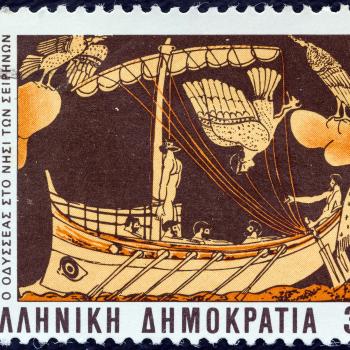Students read Raymond Carver's story "A Small, Good Thing," focusing on characterization in order to develop one of the static charactersthe hit-and-run driver who causes Scotty's deathmore fully.

Developing Characterization in Raymond Carver's "A Small, Good Thing"

Grades
|
Discovering Memory: Li-Young Lee's Poem "Mnemonic" and the Brain
6 - 8
Lesson Plan
| Unit
Students learn about memory by doing a memory-writing exercise, studying the brain to understand how it affects memory, reading Li-Young Lee's poem "Mnemonic," and creating projects to demonstrate their understanding.

Grades
|
Weaving the Old into the New: Pairing The Odyssey with Contemporary Works
9 - 12
Lesson Plan
| Standard Lesson
After exploring The Odyssey and a contemporary epic, students choose paired characters from the texts, complete a graphic organizer, and place their characters in hypothetical contemporary situations.

Grades
|
Finding Poetry in Prose: Reading and Writing Love Poems
9 - 12
Lesson Plan
| Standard Lesson
After reading several poems that expand the definition of love poetry, students compose found poems based on a personal memoireither their own or a love story of another writer.

Grades
|
Many Years Later: Responding to Gwendolyn Brooks' "We Real Cool"
9 - 12
Lesson Plan
| Standard Lesson
Students analyze the Gwendolyn Brooks' poem "We Real Cool" and then write about how the character's pool hall days might influence who the character becomes fifty years in the future.

Grades
|
The Day Jimmy's Boa Taught Cause and Effect
K - 2
Lesson Plan
| Standard Lesson
This lesson introduces the concept of cause and effect with Trinka Hakes Noble's books about Jimmy and his boa constrictor.

Grades
|
Connecting Past and Present: A Local Research Project
9 - 12
Lesson Plan
| Unit
In this unit, students become active archivists, gathering photos, artifacts, and stories for a museum exhibit that highlights one decade in their school's history.

Grades
|
Creative Problem-Solving with Ezra Jack Keats
K - 2
Lesson Plan
| Unit
Using books by Ezra Jack Keats as inspiration, students explore problems and solutions through read-alouds, discussion, and an interactive bulletin board.

Grades
|
The Children's Picture Book Project
9 - 12
Lesson Plan
| Unit
In this lesson students evaluate published children's picture storybooks. Students then plan, write, illustrate, and publish their own children's picture books.

Grades
|
Bio-graph: Graphing Life Events
9 - 12
Lesson Plan
| Standard Lesson
Students interview other students, choose significant life events, rate them, graph them, and write about one or more, in this activity that integrates mathematical graphing with writing.

Grades
|
Thinking Inductively: A Close Reading of Seamus Heaney's "Blackberry Picking"
9 - 12
Lesson Plan
| Standard Lesson
This lesson eases students' fear of interpreting complex poetry by teaching them a strategy with which they determine patterns of imagery, diction, and figurative language in order to unlock meaning.

Grades
|
Love of War in Tim O'Brien's "How to Tell a True War Story"
9 - 12
Lesson Plan
| Unit
Students explore the theme of love of war through texts on camaraderie among soldiers. They then compose a visual collage depicting their beliefs about the relationship between love and war.

Grades
|
More than One Way to Create Vivid Verbs
6 - 8
Lesson Plan
| Standard Lesson
This lesson teaches students how to use old verbs in a new way, thus creating new and fresh descriptive phrases.

Grades
|
When Less IS More—Understanding Minimalist Fiction
9 - 12
Lesson Plan
| Standard Lesson
This lesson pairs Ernest Hemingway's short story "Cat in the Rain' with Raymond Carver's "Little Things" to guide students to an understanding of the characteristics of minimalist fiction.

Grades
|
Assessing Cultural Relevance: Exploring Personal Connections to a Text
9 - 12
Lesson Plan
| Standard Lesson
As a class, students evaluate a nonfiction or realistic fiction text for its cultural relevance to themselves personally and as a group.

Grades
|
Brochures: Writing for Audience and Purpose
9 - 12
Lesson Plan
| Unit
Students create brochures on the same topic as another piece of writing they have done, highlighting how shifting purposes and audiences creates changes in their strategies as writers.

Grades
|
Family Memoir: Getting Acquainted With Generations Before Us
9 - 12
Lesson Plan
| Unit
Creating a memoir of an older family member allows students both to learn more about their own backgrounds and to learn the power of storytellers.

Grades
|
Exploring Irony in the Conclusion of All Quiet on the Western Front
9 - 12
Lesson Plan
| Standard Lesson
After reading All Quiet on the Western Front, students discuss the novel's ironic ending, then compose alternate titles and endings for the book, and design new book covers.

Grades
|
Supporting Vocabulary Development with EASE
6 - 8
Lesson Plan
| Standard Lesson
This lesson allows teachers to enrich students' oral and written vocabulary using the EASE sequence of instruction: Enunciate, Associate, Synthesize, and Emphasize the words you want students to use.

Grades
|
Enchanting Readers with Revisionist Fairy Tales
6 - 8
Lesson Plan
| Standard Lesson
Students examine three examples of revisionist fairy tales in which female characters act in empowered roles rather than behaving helpless and submissive.